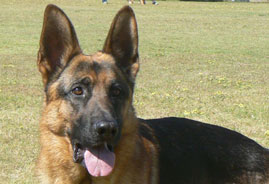Related sites with
loads of relavent and quality information:
|
Training
the Pause Table - Part 3
Fast Sit or Down
By MS du Toit
This
part of the chain, as well as the following two parts, are trained away
from the table. In fact it should be trained away from the agility
course as a whole. Again, get your clicker and treats ready. I would
suggest that you have you dog off lead, assuming you have control over
him and also that he can already perform the sit
and down commands. If not, that should be trained first. This step is
only to train your dog to perform the sit and down very fast. The sit
and down works exactly the same, so I will only talk about the down
command, since it is just a little bit more difficult. Practice the sit
and down commands in different training sessions.
With your dog in front of you, or next to you, give the down command,
while at the same time luring your dog with a treat into the down
position. The luring action should be a fast downward movement of your
hand, also bending your body. Click
and treat the moment the dog goes into the down position.
Repeat this several times. Start clicking only for very fast downs. If
your dog does not perform the down fast enough, give a no-reward marker
and try again. A no-reward marker is just a word you say like “sorry”
or “wrong”. Your dog will learn that when you say that word, he will
not be treated. Do not punish your dog.
Once your dog reliably performs a fast down from a stationary position,
you can add some action. Let him walk with you, not necessary for an
obedience heel, but he should be close to you. Then all of a sudden,
give a fast down command, with a fast downward motion of your hand.
Click and treat for a fast down. Repeat this exercise many times,
making a game out of it. You can also start running with your dog next
to you and doing the same thing.
When your dog reliably performs a very fast down from a stationary
position as well as from a walking or running position, you
can then start to reduce your own downward motion. Your aim is that you
want the same reliable performance from your dog from only a hand
signal or verbal command. Make sure to practise this every day and do
not try to progress too fast. You will later on in your dog’s agility
career be very pleased if you took the time to lay a solid foundation.
It is now time to add some distance. Use a hosepipe or tape to make a
square on the ground, almost the size of the table. The idea here is
not to send him to that square but only to let him do a fast sit or
down when he is in that square. First just walk with him, and make sure
he enters the square. Give you sit or down command, click and treat if
he responds and performs the behaviour in that square. Do that a few
times. Now run with him and do the same.Click and treat only if his
whole body is in the square. As you do this, try to get some distance
between you and the dog. If he gets that right, you are ready to go on.
If you have followed these guidelines, your dog would now be ready to
be trained the whole chained performance, provided you have also
finished the training of the other parts of the chain.
MS du Toit has been training dogs for ten years.
Please visit her Dog
Training Review Page.
Back to Top
Continue to Part 4 of the series - The
secure agility stay
Back to Part 2 - Send to the
table
Back to Articles
|
|

